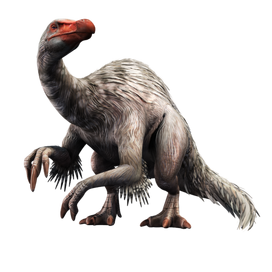Brandonjcruz (talk | contribs) (Adding categories) |
Brandonjcruz (talk | contribs) (Adding categories) |
||
| Line 25: | Line 25: | ||
[[Category:Theropods]] |
[[Category:Theropods]] |
||
[[Category:Piscivores]] |
[[Category:Piscivores]] |
||
| + | [[Category:Dinosaur Train Dinosaurs]] |
||
Revision as of 16:52, 21 July 2020

Deinocheirus (pronounced /ˌdaɪnɵˈkaɪrəs/ dy-no-ky-rəs, Greek: 'terrible hand') is a genus of large theropod dinosaur, possibly an ornithomimosaurian, which lived in what is now southern Mongolia, during the late Cretaceous Period (Nemegt Formation, dating to around 70 million years ago).
Description
The most well-preserved parts of Deinocheirus are its forelimbs, which measured 2.4 m (8 ft) long — a 938 mm humerus, 688 mm ulna and 770 mm hand — including up to 19.6 cm (8 in) long recurved claws. Each scapulocoracoid of the shoulder girdle has a length of 153 centimetres. The neck must also have been massive with each half of the paired ceratobranchialia measuring 42 centimetres.
The gigantic size of these skeletal elements has generated much speculation about the magnitude of the animal as a whole. Osmólska and Roniewicz thought it could be best compared with the Ornithomimosauria, as the structure of its arms is similar to the members of this group. Should Deinocheirus itself be a member this would make it by far the largest ornithomimosaur, indeed, one of the largest theropods. The describers estimated its size to be equal to the largest specimens of Tyrannosaurus.Its weight was in 1988 estimated by Gregory S. Paul to have been between six and twelve tonnes.Later estimates confirmed a number of roughly 9,000 kg (20,000 lb). In 2010 Paul revised this to a length of ten metres and a weight of two tonnes.
In 2010, Phil Senter and H.J. Robins attempted to estimate the total height at the hip of Deinocheirus. By studying more completely known theropods, they found that the length of the scapula (shoulder blade), better than that of the humerus (upper arm bone), could be used to accurately predict hip height. Using the equation found over a range of theropods, Senter and Robins determined that Deinocheirus likely measured 3.3 m (11 ft) -3.6 m (12 ft) tall at the hip. This places it as possibly the tallest known theropod, taller than any contemporary predators such as Tarbosaurus.
Though the arms of Deinocheirus have a considerable absolute size, being the longest of any known theropod, they are not very long relative to the shoulder girdle, the ratio being less than that with most ornithomimosaurs. The shoulder-blade is long and narrow. The humerus is relatively slender. The ulna and radius too are elongated and not very firmly connected to each other in a syndesmosis. The metacarpus is long compared to the fingers. The hand had a good mobility relative to the lower arm but was only capable of a limited flexing motion, unable to close in grasping. The fingers are about equal in length to each other, the first being the stoutest and the second the longest. Only the claw of the left second finger has been preserved in its entirety; it has a diameter of 196 millimetres and a length along its outer curvature of 323 millimetres.coui
Deinocheirus's diet is uncertain, but due to its classification and the fact that fish scales and plants were discovered inside the stomach, it is most likely an omnivore. Furthermore, the mouth was adapted to eat small plants and animals, and occasionally, fungi.
In Popular Culture
Due to it only been known by arms for decades, it hasen't been in pop culture much:
- It appeared in Bizarre Dinosaurs as a therizinosaurid.
- It has also appears in Jurassic World: The Game as a tournament dinosaur. Due it coming out in 2015, the Deinocheirus in Jurassic World: The Game is the most accurate Deinocheirus to date. While it is accurately portrayed with a coat of feathers, it is shown inaccurately to be able to pronate it's hands. Its hump appears to be much less pronounced than in real life, until its final evolution. Despite being an ornithomimid, in the game, it uses the same model for the therizinosaurids, Therizinosaurus, Segnosaurus, and Erlikosaurus although it is likely because Deinocheirus looks more like a therizinosaurid than a ornithomimid.